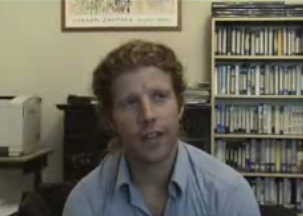Noam Bedein, a young resident of Sderot, Israel and creator of Sderot Media Center, traveled to Brandeis’ Rapaporte Treasure Hall this past Tuesday to discuss the violence occurring in his little town near the Gaza Strip.
The event was sponsored by BZA – the Brandeis Zionist Alliance, an organization that aims to educate students about Israel and increase awareness of Israeli culture and news.
In the three years that Bedein, a photojournalist, has lived in Sderot, he has experienced the falling of over 7,000 Qassam rocket in his town.
Bedein’s ultimate goal is to make people aware of the crisis and present the Israeli perspective that is not often portrayed accurately in the media, he said.
Noam Bedein
Bedein spoke for about an hour and a half about Sderot, showing several video clips, most of which showed the final moments – 15 seconds from the time the “color red” alert goes off – before a rocket hits: scenes of chaos, adults running for shelter, children hiding in rooms, singing loudly to avoid hearing the blast of missiles. And then, silence.
One of the clips Bedein showed emphasized a biased media spin; to an uninformed person, it would appear that the fault was that of the Israelis.
The violence in Sderot has become such a constant part of daily life that, as Bedein pointed out, there are shelters right next to day care centers.
The citizens have come to integrate the rocket fire – at least three per day – into their lives, he explained.
The violence and “rocket reality,” as Bedein calls it, raise the question: why don’t the citizens of Sderot just leave?
Despite the fact that between 4,000 and 7,000 people have left Sderot in the past three years, Bedein explained that there are two reasons why many of the victims remain firmly planted in their small city.
First, a majority of the people living in Sderot cannot afford to leave. Second, many believe that if the rockets are not being fired at Sderot, they will be fired at another target.
They believe that if they leave, the violence will follow. For them, leaving would be giving in to terrorism.
In another effort to inform people of the situation and help those who are forced to endure the violence, the Sderot Media Center (SMC) has created the Sderot Community Treatment Theater.
SderotMedia.com says that the theater “provides therapeutic community theater treatment for young people who have been diagnosed with symptoms of post traumatic stress syndrome, while working with these people to present their reality to the people of Israel through the creative means of the theater.”
Dec. 19 is the end of the ceasefire. Bedein’s hope is that increased awareness of the issue will lead people to start talking about the Sderot situation, and help provoke a change in the area. His idea is that in going outside of Sderot, he can bring help to areas inside the city.
In a town where, as Bedein pointed out, “every street, every road, every family has experienced a rocket going off,” SMC believes that something must be done.











Recently I met you at HAFTR High School, we talked about how my relatives in Israel knew people in Sderot and I just wanted to tell you again, I think that this is a great thing you’re doing, Ha Olam Be’emet Tzarich Lada’at Al Matzav Shel Sderot. Yasher Co’ach La’avodah Shelcha Ve Ani Yaase Mashe Ani Yachol La’azor Lecha.